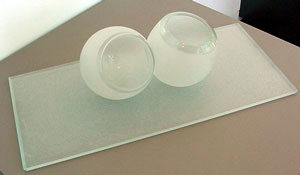Stephen Procter

Double gatherer, 1995, blown & cut glass forms, polished and engraved surface - glass base
Cultural background:
Both parents were born in England
Place of origin:
Stephen was born 1946 in West Sussex, England
Start of migration journey:
London, England - 1992
Place of arrival in Australia:
Sydney, NSW - 1992
First home in Australia:
Red Hill, Canberra, ACT
Initial employment in Australia:
1992 Head of Glass Workshop, Canberra School of Art, Australian National University(ANU)
Other employment in Australia:
Freelance Artist
Any glass related objects that you brought with you? And still have?: Stephen brought over a whole container with his entire studio set up from England, which included 2 lathes, an engraver,
flatbed, and a multitude of tools.
Stephen's story
Stephen Procter was born in West Sussex, England where he studied engineering and agriculture; his interest in glass began during the late 1960s. He was self taught and had opportunities to work at different glass factories in England and taught himself diamond-stipple engraving. His first glass engraving studio was in Ashburton, Devon, United Kingdom(UK) in 1970. He also travelled to Vienna for a residency at Lobmeyr Glass and as visiting Artist in Residence at Illinois State University, United States of America(USA) in 1978. Subsequently he taught glass at West Surrey College of Art and Design, Surrey, England and was lecturer at The Royal College of London.
Stephen had met Klaus Moje at a glass conference where Klaus mentioned that he was leaving Canberra School of Art, as Head of the Glass Workshop. Stephen was offered the position and the University ended up sponsoring him for a Residency Visa.
In 1992, Stephen arrived in Australia along with his wife Christine and two children Anna and Ben to commence his position at Canberra School of Art. In 1994 the family moved to the countryside just outside of Canberra, a place that gave Stephen a renewed connection to the land. His time at Canberra School of Art was a vital one and his responsibility as a teacher became the central focus. He encouraged his students to travel and meet new people and shared the network of contacts that he had through living and working in the UK, Europe and the USA before coming to Australia.
The Glass Workshop participated in many international events including in 1998 the Venezia Aperto Vetro exhibition in Venice; he continued and encouraged the close relationship with Bullseye Glass via the touring exhibitions and Latitudes workshop. After arriving here he extended his travels to Asia where in 1998 he undertook an Australia Council Residency in Taiwan.
Stephens' work was very much about light, which was the reason he stayed with the medium of glass. Although he started as an engraver, using a stipple engraving tool to punctuate dots of light into the dark glass, he soon worked with sculptural forms, which became volumes and containers of light. His work represented ideas of light and colour, stillness and purity,
balance and poise.
He experimented with prisms in his sculptural works by prismatic cutting on the edges of his vessels and also created prism installations in various locations. He created an interactive prism installation in a gallery in North England, an installation of several large free standing prisms at Taipei University Gallery, Taiwan, and one called 'Light Works' the Australian National University(ANU) commissioned for the foyer of the Innovations Building, which was completed in 2000. He was fascinated working with pure colours generated by a prism and the constant change of light and colour throughout the day, depending on the time of day, the amount of sunlight and the position of the viewer. The piece creating a surprise and at that precise moment an unexpected rainbow appears on a large white wall when, maybe just an hour before or after, this splash of colour is not visible.
Stephens' work has been widely exhibited and collected throughout the world by private collectors and prominent art
museums such as the Victoria and Albert Museum, London, UK; Kunstmuseum Düsseldorf, Germany; Royal Museum of Scotland, Edinburgh, UK; Museum of Decorative Art, Lausanne, Switzerland; National Museum of Modern Art, Kyoto, Japan; National Gallery of Victoria, Australia; Parliament House Art Collection, Australia; The National Gallery, Australia.
Initially Stephen and his family thought they would only stay in Australia for a limited period of time but moving here was an important step for him with the bold, strong, powerful landscape, the intense light, the sense of space and a new palette of ochres, reds and greys inspiring him to new work.
Stephen enjoyed the mental differences between a culture like Britain that is so steeped in history to a newer country where he felt fewer bounds of historic passage.
Stephen Procter was Head of the Glass Workshop, Canberra School of Art from his arrival in 1992 until his sad passing in August 2001. Glass artists together with the ANU raised funds to set up the Stephen Procter Fellowship to honour his
memory. The aim of the award is to assist an Australian artist and an international artist, one each alternate year to travel and study abroad or come to Australia and work at the Canberra School of Art. Experience and travel were important to Stephen and this Fellowship is intended to establish links between glass makers around the world. (This story is written
directly from an interview and information kindly supplied by Stephens' wife Christine Procter)